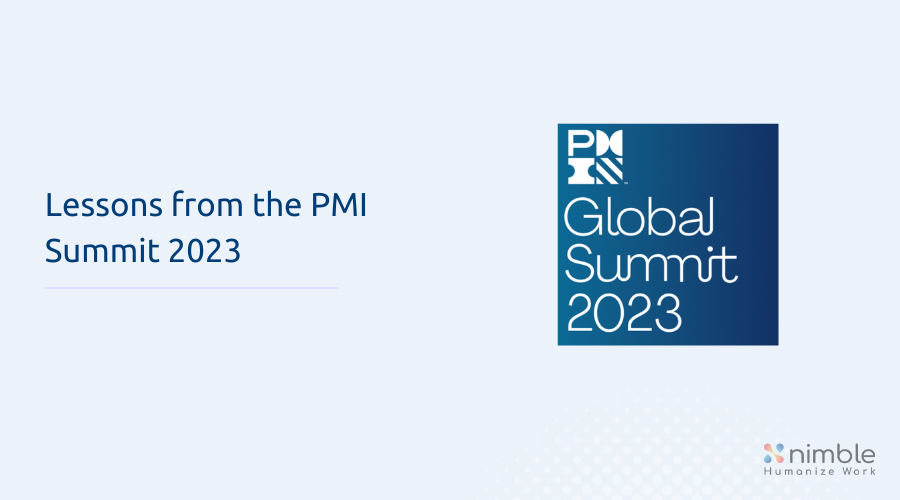This year, we participated in the Project Management Institute’s annual PMI Summit, held in Atlanta. Over the course of two and a half days, we met with a wide range of people from different companies and different countries. While many of them did not have a lot of time to spare, we still managed to connect with at least over a hundred people with whom we had some great conversations.
We were keen to learn what occupied the minds of project managers in the current times. So we asked various questions – and listened closely to the answers that we received. In the article, we’d like to share some of the key lessons we learned from these conversations, which we believe would be of importance to all of you as well.
1. With the advent of technology, especially mobile and AI – how has the job of a project manager evolved? Has it become easier in many ways?
Mobile devices and technologies have certainly eased things a lot, especially on the go. Having devices and collaboration tools at hand provides access to stakeholders and team members has made it easier to stay connected and to communicate, collaborate and set expectations on a more timely basis.
However, the same devices and tools have made things far more challenging – both in terms of the expectations of responsiveness and the demand for an increase in frequency of updates. The expectation of project managers to stay on top of messaging and communication, especially responses to queries, appear to have reached unreasonable levels. Only the most compassionate and caring work environments appear to try and control these expectations.
The arrival of ChatGPT in late 2022 and widespread use by early 2023 has laid open a treasure trove of information and answers for project managers – and really given them a lot to work with – significantly reducing the research time they would otherwise spend on search engines, manually extracting, compiling, collating the final output they needed. At the same time, it has – at least so far – not threatened any project management jobs just yet.
However, the real benefits of AI that have been touted for a long time, are still elusive. Be it risk forecasting and mitigation, project forecasting, resource demand forecasting and supply management, where there is a dearth of sufficient and high quality data for AI forecasting engines to read, things still continue to be where they have been. Project managers still need to depend on organizational SMEs for many of these answers and a lot of these still get managed reactively (after the problem has occurred or the risk has materialized) rather than proactively, while trying to minimize the cost to the customer and organization.
So, the challenges of the iron triangle – schedule, scope and cost – remain fundamentally the same. The job of the Project Manager remains as challenging as ever – probably even more challenging than before.
2. What project management method does your organization use predominantly? Traditional (waterfall), Agile (Scrum, Kanban, other) or Hybrid?
Here the answer seemed pretty clear. The method wars appear largely to be over. Organizations and leadership understand the relative advantages and disadvantages of traditional and agile approaches – and are clear they need to move in the direction of agile. They are implementing Agile or Hybrid Agile methods judiciously where possible.
In our estimate, at least 50-60% of the people we spoke to said that their organizations were Hybrid Agile organizations. However, there were two variants to this answer. By Hybrid Agile, some people meant that they had some teams in the company that used traditional methods while others used Agile methods.
On the other hand, others said that they managed their projects using a Hybrid Agile approach, where they did high-level milestones and deliverable planning the traditional way, but then executed the project using Agile methodologies. This meant that they took some efforts to dovetail the milestone-based plan to a sprint-based schedule – and not all of them had the right set of tools to do so easily.
Given the above, it appears to us that a good 25-30% of organizations still run projects using traditional methods. These also include those industries where adoption of large scale agile was not feasible due to the nature of the project deliverables.
3. What is the nature of the PMO and PM functions in your organization? Is the PMO part of IT or reports to the business head? How are your project management related roles changing due to adoption of Agile?
Based on the responses we got, it is clear that the understanding of the Project Management Office is evolving. In a recent survey we did, we found that an equal number of organizations have the PMO housed within IT and outside IT. The role of the PMO is evolving to include SMEs/ coaches/ trainers on Agile methods and Agile Project Management, who are helping teams transition from traditional to Hybrid Agile and pure Agile. They are also helping teams adopt agile principles and techniques more suitable to software and product development to operations/ business projects.
Agile methods have bought one level of uncertainty in terms of how their role should evolve. Organizations have chosen to either keep both traditional and agile roles while encouraging their PMs to train in Agile and get Agile PM training and certifications. On the IT side, roles such as Scrum Masters and Product Owners have been more easy to implement, but outside IT, it appears to be a mixed situation.
4. The domain of Project Management is diverging between IT and non-IT worlds. This is evident when you speak to them, individually.
It is clear that companies are doing more projects across more parts of the organization than ever before. As per data shared by Antonio Nieto-Rodriguez, in his HBR article – The Project Economy has Arrived – organizations are spending for the first time ever more on new projects than business-as-usual expenses.
The role of IT and tech organizations in a company has become more integrated with the rest of the business, thanks to the digital transformation initiatives in almost all types of businesses. At the same time, project management responsibility has become more dispersed with more of it moving to functions such as operations, marketing & sales, HR and finance. This has resulted in a variety of initiatives by companies – from reorienting entire functions to be project led to providing more employees project management training so they can run their business projects more efficiently and effectively.
Talking to the PMI attendees, it was clear that project management was growing more critical – and business teams were taking on greater levels of project management responsibility.
5. Everyone is struggling with the core issue of building team connectedness. People are generally disassociated with the work they are doing. They are doing what they are asked to do and beyond that, there is a level of disengagement. Hence, Nimble’s HumanizeWork approach resonated with many of the conference attendees.
This has been a challenge for organizations worldwide since the Covid pandemic and its aftermath. The pandemic isolated people in their own homes and while the ability to work from home and the resulting flexibility gave a fillip to productivity and employee morale, it also quickly led to a feeling of isolation and disconnectedness which started to pose new challenges to organizations.
The one aspect that found a lot of resonance was the challenge of working remotely while some of the team members are at work. The mix of in-person and remote team members in a meeting or discussion appears to cause the most challenge for the remote folks.
In general, team leaders and organizations are struggling with the disengagement with work further exacerbated by this disconnectedness. The need to find ways to provide teams and individuals their purpose – and get alignment between organizational and team/ individual goals has never been more.
All in all, we had an amazing time speaking to people from all over the world – and learning from their experiences. Our “Humanize Work” message really resonated with many of the folks we spoke with and they felt we were moving in the right direction to help organizations and teams address this challenge.
If you or your teams are struggling with this issue and you’d like to learn more about how we might help – or are looking for effective tools to manage Hybrid Agile projects, we’d love to hear from you!

